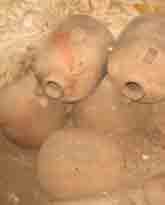Jerusalem Conference

The Conference Program (Hebrew)
Source: Israel Antiquities Authority Events Calendar The following conference was publicized in Israeli newspapers this weekend. Maybe I'll end up attending. Here is a translation of the program.
The Ingeborg Rennert Center for Jerusalem Studies, The Martin (Szusz) Department of Land of Israel Studies and Archaeology, The Faculty of Jewish Studies, Bar-Ilan University, in cooperation with: Yad Ben-Zvi, The Center for the Study of the Land of Israel, and the Israel Antiquities Authority: Jerusalem District
are honored to invite the public for the 11th yearly conference on the topic:
This coming Thursday, Nissan 1, 5766 (March 30, 2006), in the Mintz Auditorium (Building 403), at Bar Ilan University.
The Program follows ...
:
8:00 - Gathering
8:30 - Opening Remarks and greetings
- Prof. Moses Orfali, Dean of the Faculty of Jewish Studies at Bar Ilan University
- Prof. Joshua Schwartz, Director of the Ingeborg Rennert Center for Jerusalem Studies
- Mr. Shuka Dorfman, Manager of the Antiquities Authority
- Mr. Jon Seligman, Jerusalem District Archaeologist
- 8:50 - Eilat Mazar - "Have we uncovered King David's Palace?"
- 9:10 - Ronny Reich and Eli Shukrun, "Excavations at the 'Hewn Pool' near the Gihon Spring."
- 9:30 - Michael Avioz, "The Date of the Destruction of the First Temple in the Bible and Post-Biblical Sources."
- 9:50 - Uri Davidovitz, Yoav Pirchi, Shlomo Kol-Yaacov, Misgav Har-Peled, Dalit Weinblatt-Krauss, and Yoav Alon - "Salvage Excavations at the Ramot Forest and Ramat Beit HaKerem: A New Source for Understanding the Agricultural Periphery of Jerusalem in the First and Second Temple Period."
- 10:10 - Asher Grossberg - "How did Hezekiah prepare for the Siege by Sennacherib?"
- 10:30 - Immanuel Eisenberg and *Alon De Groot - "An Iron Age Fort near Ramat Rahel."
- 10:50 - Discussion
- 11:00 - Pause
- 11:20 - Opening Remarks - Zvi Greenhut - "Survey of the Digs in the Jerusalem Area in 2005."
- 11:35 - Haim Barba and Tufiq Da'adla - "Jerusalem, the Old City, the Ohel Yitzhak Synagogue on the Gei Street."
- 11:55 - Jacob Billig - "The Many Facets of the Herodian Gates on the Temple Mount."
- 12:15 - Zvi Greenhut - "A Living District Dating to the Second Temple Period in the Slopes of the Upper City - Jerusalem."
- 12:35 - Yehoshua Peleg - "The Temple in the Dora Europos Synagogue Drawings."
- 12:55 - Ram Bouchnik, Guy Bar-Oz, Eli Shukrun, and Ronny Reich - "Animal Bones from the Late Second Temple Period at the Hewn Pool near the Gihon Spring in Jerusalem."
- 13:15 - Discussion
- 13:25 - Lunch
- 14:30 - Yael Israeli - "A Glass Factory in the Jewish Quarter from the Herodian Period."
- 14:50 - Hillel Geva - "Stone Implements from the Herodian Period in the Jewish Quarter - An Attempt at a Typology."
- 15:10 - Yuval Shahar - "What Happened to a Jerusalemite Exile: Did Rabban Yohanan Ben Zakkai leave Yavneh for Beror-Hayil?"
- 15:30 - Gabriel Barkay and Zachi Zweig - "The Temple Mount Dump Filtering Project - Initial Report."
- 15:50 - Amos Kloner - "The Dating of the Southern Dechomenos of Aelia Capitolina and the Wilson Arch."
- 16:10 - Yuval Baruch and Ronny Reich - "Remains of the Aelia Capitolina Period near the South Eastern Corner of the Temple Mount."
- 16:30 - Discussion
- 16:40 - Pause
- 17:00 - Tziona Grossmark - "R' Zera said: 'Because no furnaces are made in Jerusalem.' (Bavli, Zevahim 96a)."
- 17:20 - Shlomit Weksler-Bdolah - "Possible Interpretations of the Repetitive Use of Building Materials from an Earlier Source (spolia) in the Monumental Building of Jerusalem in the Late Ancient Age."
- 17:40 - Haim Barba and Yechiel Zelinger - "A Monastery from the Byzantine Period near the Qidron Valley."
- 18:00 - Deborah Sklar-Parnes, Alon De Groot, Rachel Bar-Natan and David Amit - "New Excavations near the Third Wall."
- 18:20 - Irena Zilberbod and David Amit - "The Antilia Well at the Timnah Valley."
- 18:40 - Avi Sasson - "Water for the Walker and Pilgrim - Water Provision in Jerusalem from the Ayyubian Period to the Late Ottoman Period - Archaeological, Geographical and Social Perspectives."
- 19:00 - Discussion
The Conference is dedicated to the memory of Israel Shalem, of blessed memory, a colleague at the Rennert Center.
For Details, call the Ingeborg Rennert Center for Jerusalem Studies, Bar Ilan University at +972-3-5317703
The public is invited. Read the rest of this post!







